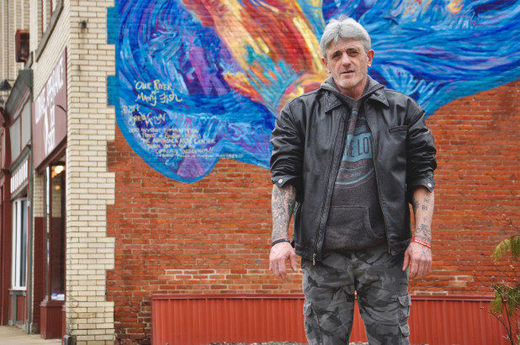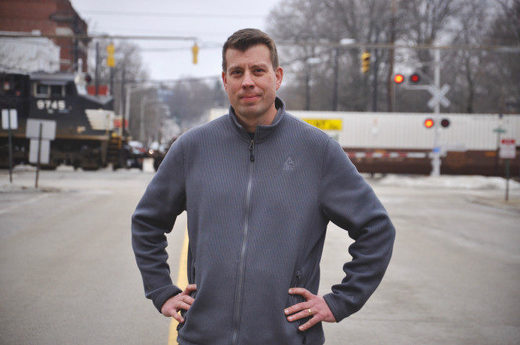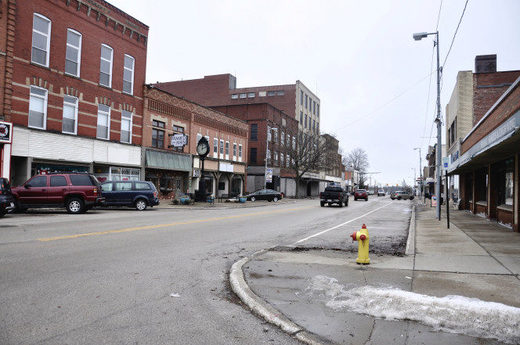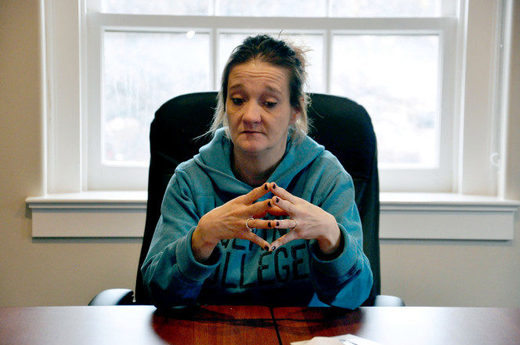
© Shannon Venditti
Bart Strickler says he used meth to treat the symptoms of mental illness because it was cheap and easy to get.
Bart Strickler drank his first beer at 9, smoked his first joint at 10. By the time he was in middle school he'd already done acid, cocaine, LSD, Quaaludes and anything else he could get his hands on.
"I shouldn't be here," he says numbly. He takes a deep breath as the past flutters across his face.
"I shouldn't be here."
The 52-year-old Strickler sits at the end of a long table in a rehab center on Main Avenue, backlit by a single window.
His arms are covered with "jail tats" from his 15 years in federal prison on aggravated assault and weapons charges. "I am trying to beat meth before meth beats me."
He fiddles with a scar on his left wrist: "That was from the second time I tried to kill myself. The first time I had a shotgun, cocked and in my mouth and getting the nerve to pull the trigger when my damn neighbors came to the house."
In October 2018, President Trump signed a breakthrough bipartisan bill aimed at dealing with the country's drug-addiction epidemic, which most people associate with opioids. And for good reason: In 2017, there were 70,237 opioid overdose deaths in the United States - a 9.6 percent uptick from the previous year, according to the CDC.
But meth is claiming lives at a rapidly increasing rate as well.
In 2017, 10,000 Americans died from an overdose involving psychostimulants (meth as well as ecstasy and some prescribed stimulants) - a 33.3 percent jump from 2016, the CDC reported.
And, in Ohio, overdose deaths involving meth have seen one of the steepest rises in the country, jumping 5,000 percent from 2010 (nine deaths) to 2017 (509 deaths), according to a report by the Ohio Alliance for Innovation in Population Health. The rush of meth into the state from the border is overwhelming: "It is raining drugs," said Taylor Cleveland, an Ashtabula County sheriff's officer assigned to the task force for the US Drug Enforcement Administration.
The youngest of eight, Strickler only made it through the 10th grade. He says he stayed home to care for his dying parents. His father - who he describes as a brutal man who beat him often and shot at him once - succumbed to black-lung disease; so did his mother, who followed her husband's mining jobs through West Virginia coal towns.
Following release from prison in 2003, Strickler became addicted to opioids after being injured in a car accident. He quit cold turkey in 2014 when the doctor supplying his drugs skipped town.

© Shannon Venditti
DEA officer Taylor Cleveland
One month later, he says, his stepdaughter offered him meth, and he was addicted instantly. He hit rock bottom last year when he was arrested for possession and went into treatment, and relapsed as recently as last week, when he found meth he'd hidden and forgotten about.
Experts say addicts like Strickler are increasingly replacing heroin - known as "slow" on the streets - with "go," also known as meth, which can be smoked, snorted or injected. "Part of the reason meth is overtaking the market is this common misconception you can only die from opioid overdose and you are safer with meth," explained Stacy Smith, the dual diagnosis therapist at Signature Health, the Ashtabula rehab center where Stickler is being treated. "It's not safer. It can stop your heart."
"The other reason is price," explains Ashtabula County District Attorney Nick Iarocci.
"It's cheap. And abundant. That is why we are seeing a dramatic escalation of crystal methamphetamine use because it is being shipped to our county at the border. People aren't making it anymore, because it comes here so cheap from Mexico." Cleveland says meth labs started popping up in Ashtabula in 2002, but due to a crackdown "in the last 18 months, we've seen almost a wholesale elimination" of them. "That void . . . is being filled by Mexican cartels bringing meth across the borders," he adds.
The DEA has pinpointed Akron, Ohio, as one of the major drop-off points for meth coming from Mexico and being distributed throughout the Midwest and Northeast.

© Shannon Venditti
“It is raining drugs” in Ohio, said Taylor Cleveland, an Ashtabula County sheriff’s officer assigned to the task force for the US Drug Enforcement Administration.
To combat the problem, Cleveland says police mainly focus on raiding the homes of known suppliers.
"We just pulled a guy over that came out of the house," he says, pointing to a nearby building.
He's confessing right now. We're gonna run up to this house in about 15 minutes with a search warrant and seize the meth and try and roll into his Mexican source in Akron. That's the same thing that we've been doing since Pablo Escobar in 1980."
While the media often blames America's drug crisis on economic despair,
officials and addicts point to mental illness and unresolved trauma as the deeper cause. "I'm bipolar, and I also suffer from depression, which is why I tried suicide," Strickler says. "You don't know how many times it goes through my mind: 'Why in the hell are you even living?' I've cussed God, and I feel so bad - 'Why in the hell did you ever do this to me?' But I know I've done it to myself. He didn't do it to me."
Cleveland explains the cycle: "Often times, people self-medicate with readily available drugs, they become addicted, and then they have these parallel issues going on. Maybe they're undiagnosed bipolar, and you know what calms them down? A little bit of weed. You know what speeds them up a little bit when they're depressed? A little bit of meth or a little bit of coke."
Do that, he says, and "you get addiction."

© Shannon Venditti
Linda Dibell
Linda Dibell, 40, is so distraught she almost shrinks inwardly as she talks. She says addiction didn't hit her till her mid-20s after her daughter's birth. She wears a baby-blue sweatshirt, long auburn hair tied in a knot; she fidgets, talking about her life's "downward spiral."
Tears stream down her face as she describes her 17-year-old daughter, in rehab for meth addiction for which Dibell blames herself: "It makes me feel like s-t. Honestly."
The Ashtabula native says every time she becomes depressed, she relapses. "I have suffered with mental illness issues . . ." she says, her voice trailing off.
Dibell is at a juncture: Her daughter completes rehab at month's end but has said she won't return home because of a violent altercation with her stepfather. She also told Dibell she'll use meth again if out on her own.
Dibell knows her obligation is with her daughter; she knows economic security is with her husband. She found out just that morning that she got a job at a temp agency.
She last relapsed on New Year's Eve and doesn't want to again: "I've made a lot of bad choices. Bad choices. I'm just trying. I am. I'm trying."
In 2015, Republican Gov. John Kasich defied party politics by expanding Medicaid, which allowed addicts to seek treatment at places like Signature Health.
"When Ohio expanded Medicaid, it was a floodgate of lifelines to people who had been so desperately wanting treatment," said Smith.
In his inaugural address last month, new Republican Gov. Mike DeWine said he would preserve that expansion. Meanwhile, drug informants are helping lead police to low-level users who are arrested and ultimately forced to get treatment.

© Shannon Venditti
Drea Caudill
That's what happened to Drea Caudill.
When you first glimpse Caudill, 27, you think of Adele, the British songstress: Her blond hair is perfectly coifed, her flowing black frock is stylish, her lips the perfect shade of red, her eyelashes impossibly long. She's gone from casually smoking weed as a teenager to becoming a successful hairstylist in her early 20s at a Cleveland salon to a trap house filled with guns, drugs, strangers and the meth she needed to feed her fix.
"It started when a couple friends were, like, 'Hey, meet us at the beach. We're gonna go smoke some weed.' We got there, and they turned over the back of their cellphone, and they busted out some lines, which I thought was cocaine, and at the time I could do that kind of thing and I didn't think that I was an addict then," she explains.
"It was like love at first line, and I'll never forget - I called a friend a couple days later and I was, like, 'Man, I did the best coke of my life, I've been up for three days,' and they're, like, 'That's not cocaine.' I just took off from there."
Caudill says she has suffered with depression and anxiety since the eighth grade, and meth made her feel like she was invincible.
She lost the job she loved, sold all of her possessions and broke the hearts of the grandparents who raised her. Nothing was going to get in the way of that next high.
Her worst moment came last fall when a stranger messaged her on Facebook to come out and party: "I didn't know him at all [but] he knew people that I knew on Facebook, I [thought] it was okay."
In the course of the evening she got high, was temporarily abandoned at the trap house and then picked up again by the Facebook acquaintance who turned out to be a police informant. She got arrested - and that marked the first day of her new drug-free life.
"September 7th of 2018, and that is my sobriety," says Caudill, who is now trying to look toward the future.
Strickler, however, can't help but dwell on the past.
He wishes he could grab the shoulders of his 8-year-old self and give him one message: "Run. Run. Run away. Just run away. Get the hell away from that house. I wish I could tell him to run away."